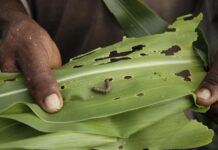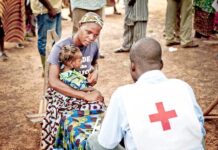A study by Wolde, S. G., D’Odorico, P., & Rulli, M. C. (2023) titled “Environmental drivers of human migration in Sub-Saharan Africa” published in the Global Sustainability, a publication of the Cambridge University Press revealed that migration can be seen as a coping mechanism or adaptation strategy to climate change in sub-Saharan Africa. The paper examines how environmental changes, such as climate events, processes, and disasters, have influenced human displacement across 32 sub-Saharan African countries between 1990 and 2021.
“
Migration can be seen as a coping mechanism or adaptation strategy to climate change in sub-Saharan Africa.
– Wolde et al., 2023
The authors out of concern for the complex and multifaceted causes and consequences of environmental migration in the region, and the lack of comprehensive and reliable data to assess its magnitude and patterns, decided to conduct this systematic literature review and meta-analysis of 87 case studies from various sources and using various methods to identify the direct and indirect environmental drivers, the geographic patterns, and the regional differences of environmental migration in sub-Saharan African countries over a 31 years period.
The authors upon learning from evidence, developed a new conceptual framework to investigate the cascading flow of interdependences among environmental change drivers of human displacement in the region – which utilized Qualitative Comparative Analysis (QCA), statistical correlation analysis, and mosaic graphs to analyze the complex causal links and interactions among the multiple factors.
Findings from their study show that environmental migration pattern in sub-Saharan Africa is mostly internal and regional, and is influenced by multiple direct and indirect factors. The direct environmental drivers are drought, floods, storms, and land degradation. While the indirect environmental drivers: water scarcity, food insecurity, conflict, and health risks. They noted that non-environmental drivers (such as political, economic, administrative, social, and development processes that lead to the depletion/degradation of natural resources) compound the effects of environmental change.
However, the main environmental factors leading to human displacement are associated with high rainfall (cyclones, storms, floods, heavy rain) or water scarcity and drought, described as push factors for human displacement across 32 sub-Saharan African countries. While the authors could not provide specific findings on the direction of the migration flow, they presented a conceptual framework for investigating the cascading flow of interdependences among environmental change drivers of human displacement while reconstructing the main migration patterns across sub-Saharan Africa.
The authors identified migration as a coping mechanism or adaptation strategy to climate change in sub-Saharan Africa when coupled with resilience-building techniques. It also explores how migration might contribute to planned relocation as a climate-change adaptation measure. It highlights the challenges and opportunities for enhancing societal resilience in sub-Saharan African countries.
Implications of the study
The study provides a better understanding of the complex web of environmental drivers of environmental migration in sub-Saharan Africa while highlighting sub-regional differences in the predominant environmental forcing. The study also highlights the need for a better understanding of the role played by non-environmental factors in the migration and internal displacement process in sub-Saharan Africa. The study argues that hydroclimatic changes may increase or decrease the plausibility of migration, but these outcomes highly depend on the underlying non-environmental contexts. The study suggests that policymakers and practitioners need to take into account the complex interplay of environmental and non-environmental factors when designing and implementing policies and programs aimed at reducing vulnerability and enhancing resilience to environmental change in sub-Saharan Africa.
In conclusion, this comprehensive study sheds valuable light on the intricate dynamics of environmental migration in sub-Saharan Africa over three decades. It uncovers the diverse factors propelling human displacement, distinguishing between direct drivers like droughts and floods and indirect ones such as water scarcity and conflict. Notably, the research underscores the pivotal role of non-environmental factors in compounding these migratory patterns. Furthermore, the study introduces a groundbreaking conceptual framework, bridging the gap between environmental change and human mobility. It highlights the dual nature of migration as both a response to climate change and a potential catalyst for planned relocation and adaptation strategies. Ultimately, the findings emphasize the necessity for policymakers and practitioners to consider this intricate interplay of factors in crafting effective strategies to bolster resilience and reduce vulnerability in the face of environmental shifts across sub-Saharan Africa.

Question for Contribution and Comments
Dear reader, we value your input! Kindly share your thoughts, ideas, and comments regarding the question below in the comment section. Your valuable input will help shape our next article:
“What are the ethical considerations and potential consequences of using migration as an adaptation strategy to climate change in sub-Saharan Africa, especially in the context of complex interactions with non-environmental factors?”
















 The African Research (AR) Index is a comprehensive scholarly directory and database focused explicitly on journal publishers that publish and disseminate African research.
The African Research (AR) Index is a comprehensive scholarly directory and database focused explicitly on journal publishers that publish and disseminate African research.

